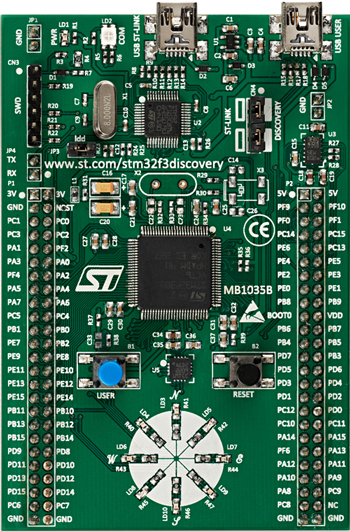ST STM32F3DISCOVERY¶
Overview¶
The STM32F3DISCOVERY Discovery kit features an ARM Cortex-M4 based STM32F303VC MCU with everything required for beginners and experienced users to get started quickly. Here are some highlights of the STM32F3DISCOVERY board:
STM32 microcontroller in LQFP100 package
Extension header for all LQFP100 I/Os for quick connection to prototyping board and easy probing
On-board, ST-LINK/V2 for PCB version A or B or ST-LINK/V2-B for PCB version C and newer, debugger/programmer with SWD connector
Board power supply: through USB bus or from an external 3 V or 5 V supply voltage
External application power supply: 3 V and 5 V
Ten LEDs:
- 3.3 V power on (LD1)
- USB communication (LD2)
- Eight user LEDs: red (LD3/LD10), blue (LD4/LD9), orange (LD5/LD9) and green (LD6/LD7)
Two push-buttons: USER and RESET
USB USER with Mini-B connector
L3GD20, ST MEMS motion sensor, 3-axis digital output gyroscope
LSM303DLHC, ST MEMS system-in-package featuring a 3D digital linear acceleration sensor and a 3D digital magnetic sensor

More information about the board can be found at the STM32F3DISCOVERY website.
Hardware¶
STM32F3DISCOVERY Discovery kit provides the following hardware components:
- STM32F303VCT6 in LQFP100 package
- ARM® 32-bit Cortex® -M4 CPU with FPU
- 72 MHz max CPU frequency
- VDD from 2.0 V to 3.6 V
- 256 KB Flash
- 40 KB SRAM
- Routine booster: 8 Kbytes of SRAM on instruction and data bus
- GPIO with external interrupt capability
- 4x12-bit ADC with 39 channels
- 2x12-bit D/A converters
- RTC
- General Purpose Timers (13)
- USART/UART (5)
- I2C (2)
- SPI (3)
- CAN
- USB 2.0 full speed interface
- Infrared transmitter
- DMA Controller
- More information about STM32F303VC can be found here:
Supported Features¶
The Zephyr stm32f3_disco board configuration supports the following hardware features:
| Interface | Controller | Driver/Component |
|---|---|---|
| NVIC | on-chip | nested vector interrupt controller |
| UART | on-chip | serial port-polling; serial port-interrupt |
| PINMUX | on-chip | pinmux |
| GPIO | on-chip | gpio |
| I2C | on-chip | i2c |
| SPI | on-chip | spi |
| USB | on-chip | USB device |
Other hardware features are not yet supported on Zephyr porting.
The default configuration can be found in the defconfig file:
boards/arm/stm32f3_disco/stm32f3_disco_defconfig
Pin Mapping¶
STM32F3DISCOVERY Discovery kit has 6 GPIO controllers. These controllers are responsible for pin muxing, input/output, pull-up, etc.
For mode details please refer to STM32F3DISCOVERY board User Manual.
Default Zephyr Peripheral Mapping:¶
- UART_1_TX : PC4
- UART_1_RX : PC5
- UART_2_TX : PA2
- UART_2_RX : PA3
- I2C1_SCL : PB6
- I2C1_SDA : PB7
- I2C2_SCL : PA9
- I2C2_SDA : PA10
- SPI1_NSS : PA4
- SPI1_SCK : PA5
- SPI1_MISO : PA6
- SPI1_MOSI : PA7
- SPI2_NSS : PB12
- SPI2_SCK : PB13
- SPI2_MISO : PB14
- SPI2_MOSI : PB15
- USB_DM : PA11
- USB_DP : PA12
- USER_PB : PA0
- LD3 : PE9
- LD4 : PE8
- LD5 : PE10
- LD6 : PE15
- LD7 : PE11
- LD8 : PE14
- LD9 : PE12
- LD10 : PE13
System Clock¶
STM32F3DISCOVERY System Clock could be driven by internal or external oscillator, as well as main PLL clock. By default System clock is driven by PLL clock at 72 MHz, driven by 8 MHz MCO from the ST Link.
Serial Port¶
STM32F3DISCOVERY Discovery kit has up to 5 UARTs. The Zephyr console output is assigned to UART1. Default settings are 115200 8N1.
I2C¶
STM32F3DISCOVERY has up to 2 I2Cs. I2C1 is connected to the LSM303DLHC and is an ultra-compact low-power system-in-package featuring a 3D digital linear acceleration sensor and a 3D digital magnetic sensor.
USB¶
STM32F3DISCOVERY has a USB 2.0 full-speed device interface available through its mini USB connector (USB USER).
Programming and Debugging¶
Flashing¶
STM32F3DISCOVERY Discovery kit includes a ST-LINK/V2 or ST-LINK/V2-B embedded debug tool interface.
Applications for the stm32f3_disco board configuration can be built and
flashed in the usual way (see Build an Application and
Run an Application for more details).
Flashing an application to STM32F3DISCOVERY¶
First, connect the STM32F3DISCOVERY Discovery kit to your host computer using the USB port to prepare it for flashing. Then build and flash your application.
Here is an example for the Hello World application.
# On Linux/macOS
cd $ZEPHYR_BASE/samples/hello_world
mkdir build && cd build
# On Windows
cd %ZEPHYR_BASE%\samples\hello_world
mkdir build & cd build
# Use cmake to configure a Ninja-based build system:
cmake -GNinja -DBOARD=stm32f3_disco ..
# Now run ninja on the generated build system:
ninja
ninja flash
Run a serial host program to connect with your board. For PCB version A or B a TTL(3.3V) serial adapter is required. For PCB version C and newer a Virtual Com Port (VCP) is available on the USB ST-LINK port.
$ minicom -D /dev/<tty device>
Replace <tty_device> with the port where the STM32F3DISCOVERY board can be found. For example, under Linux, /dev/ttyUSB0.
You should see the following message on the console:
Hello World! arm
Debugging¶
You can debug an application in the usual way. Here is an example for the Hello World application.
# On Linux/macOS
cd $ZEPHYR_BASE/samples/hello_world
mkdir build && cd build
# On Windows
cd %ZEPHYR_BASE%\samples\hello_world
mkdir build & cd build
# Use cmake to configure a Ninja-based build system:
cmake -GNinja -DBOARD=stm32f3_disco ..
# Now run ninja on the generated build system:
ninja debug